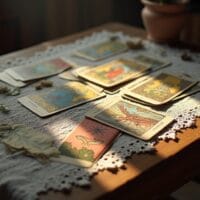Table of Contents
What is a Tarot Journal?
A tarot journal is a personalized notebook or a digital document specifically designed to record your experiences, insights, and reflections related to tarot card readings. It serves as a tool for self-reflection, learning, and a better understanding of the Tarot. A typical tarot journal includes:

- Card Interpretations: Write down all your personal interpretations for each card drawn in a reading, including traditional meanings, symbolism, and intuitive impressions.
- Reflections on Readings: Keep track of your thoughts and feelings related to the overall message of the reading, as well as any patterns or themes that you notice. The journal should capture your interpretations and reflections, creating a record of your tarot journey.
- Personal Associations: Note down any associations or connections you feel with specific cards, based on your own experiences, beliefs, or intuition.
- Experimentation and Exploration: Explore different tarot spreads, reading techniques, or approaches to interpretation. Make sure to take notes on what works best for you.
- Progress Tracking: Monitoring your progress. Over time, your journal becomes a treasure trove of past readings. You can see recurring themes, how your interpretations evolve, and how the cards guide you through different phases of life.
- Creative Expression: Some tarot journals also include drawings, sketches, or collages inspired by the cards, as well as creative writing related to tarot themes.
Ultimately, a tarot journal is a personal space for you to engage with the tarot cards on a deeper level, fostering self-awareness, intuition, and spiritual growth. It can be as structured or as free-form as you desire, tailored to your unique journey with the cards.
Finding Your Perfect Journal
There’s no rule here! Choose a notebook that fits your aesthetic. Consider if you’ll be carrying it around or keeping it at home. Remember that size matters. A pocket-sized journal is perfect for bringing with you while traveling, while a larger notebook will allow more in-depth entries. Make sure to pick thick enough paper if you plan on using markers to avoid bleed-throughs. Here are a few more tips that might be useful:
- Does your tarot deck have a specific aesthetic? Finding a journal that complements its colors or themes can create a cohesive set that feels special
- Do you need pockets for storing notes or clippings? Look for any additional features that may enhance your journaling experience, such as built-in bookmarks, elastic closures, or pockets for storing tarot cards or other accessories.
- Binding: Decide whether you prefer a journal with a spiral, stitched, or glued binding. Spiral-bound journals lay flat, making it easier to write or draw across pages, while stitched or glued bindings offer a more traditional look and feel.
- Embrace digital options: If pen-and-paper isn’t your style, journaling apps or digital notebooks can be a convenient alternative.
- Look for pre-formatted tarot journals: These often include prompts and sections specifically designed for tarot readings.
Remember that your tarot journal is your own space for self-expression and reflection, so don’t be afraid to experiment and customize it to suit your unique preferences and needs. Whether you go for a simple notebook or a more elaborate journal, what matters most is that it feels right for you and helps you progress in your tarot journey.
Building Your Tarot Knowledge
Building your tarot knowledge is a rewarding journey that involves both study and practice. First things first, you should start by familiarizing yourself with the tarot deck. A standard tarot deck consists of 78 cards divided into two main categories: the Major Arcana and the Minor Arcana.
Start by studying the 22 cards of the Major Arcana, which represent significant life themes and archetypal energies. Each card has its own unique symbolism, meanings, and associations. Dedicate a page to each card and write down everything you learned about it. Next, spet is go into the 56 cards of the Minor Arcana, which are divided into four suits: Cups, Pentacles (or Coins), Swords, and Wands (or Rods). Each suit corresponds to a different aspect of life and has its own set of meanings and themes.
Take the time to learn the traditional meanings of each tarot card, both upright and reversed. However, remember that tarot is also highly intuitive, and interpretations can vary based on context and personal intuition. Don’t forget to explore different resources.
Journal a Reading
When just starting, we recommend picking a simple reading like our Tarot Destiny Reading. Doing a simple reading will allow you to get guidance while also learning more about the tarot cards. After drawing your cards, add them to a page in your tarot journal, and start writing about your interpretation of the cards. What this spread means for you right now. How does it make you feel? Write down everything you find meaningful. With time, you will start noticing patterns between your readings that can’t really be noticed without keeping a record of them.
Here’s an example of how to journal a tarot reading:
Date: March 18, 2024
Time: 10:00 AM
Question: What do I need to focus on for personal growth and development in the coming month?
Spread: Three-Card Spread
Cards Drawn:
- The Fool (Reversed) – Represents new beginnings, taking risks, and embracing the unknown. Reversed, it may indicate hesitation, fear of change, or feeling stuck in a rut.
- The High Priestess – Symbolizes intuition, inner wisdom, and accessing the subconscious mind. It suggests a need to trust my intuition and explore my inner depths for guidance.
- The Eight of Pentacles – Signifies dedication, craftsmanship, and continuous improvement. It suggests that focusing on honing my skills and putting in consistent effort will lead to tangible progress and success.
Interpretations:
- The Fool (Reversed): This card suggests that while I may have aspirations for new beginnings and exciting opportunities, I’m holding myself back due to fear or uncertainty. It’s a reminder to let go of self-doubt and embrace the journey ahead with courage and optimism.
- The High Priestess: The presence of the High Priestess indicates that I have a deep well of intuition and inner wisdom to draw upon. It’s encouraging me to trust my instincts and listen to the quiet voice within, especially when faced with difficult decisions or uncertain circumstances.
- The Eight of Pentacles: This card reminds me of the importance of diligence and dedication in my pursuits. By focusing on refining my skills and putting in consistent effort, I can make significant progress toward my goals. It’s a reminder that mastery is achieved through practice and perseverance.
Reflection:
This reading highlights the need for me to overcome my hesitations and embrace change with a sense of adventure and openness, as symbolized by The Fool (Reversed). The High Priestess encourages me to tap into my intuition and inner guidance as I navigate the uncertainties of life. Lastly, the Eight of Pentacles reminds me of the value of hard work and dedication in achieving my goals.
As I move forward into the coming month, I will focus on stepping out of my comfort zone, trusting my instincts, and committing myself wholeheartedly to my personal and professional growth. I will remind myself that every step I take, no matter how small, brings me closer to realizing my dreams.
Outcome:
By integrating the insights from this reading into my daily life, I feel more empowered to embrace change, trust my intuition, and work diligently toward my goals. I approach the coming month with renewed confidence and determination, ready to embark on a journey of self-discovery and growth.

Write down your favorite spreads. There are thousands of different spreads out there, in books and online; we have a few here. Make sure to write down the ones you usually go to. Examine your results with different spreads, and keep trying out new ones.
Trust Your Intuition
While it’s important to study the traditional meanings and symbolism of the cards, always trust your intuition when interpreting tarot readings. Your intuition is a valuable guide that can offer unique insights and perspectives.
Remember that building your tarot knowledge is a lifelong journey, and there’s always more to learn and explore. Stay curious, open-minded, and patient as you deepen your connection to the cards and develop your own unique approach to tarot reading.




